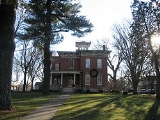
William W. Marsh House
Encyclopedia
The William W. Marsh House in Sycamore, Illinois
, the county seat of DeKalb County
, has been listed on the National Register of Historic Places
since 1978. The 1873 house was home to William W. Marsh, an inventor and is located along Illinois Route 64
as it passes through Sycamore. The Marsh House was built in the Italianate style and contains distinctive Italianate
elements such as a cupola
, a low pitched roof and eaves
supported by corbel
s.
Sycamore, Illinois
Sycamore is a city in DeKalb County, Illinois, United States. It has a commercial district based and centered on Illinois Route 64. The population was 17,519 at the 2010 census, up from 12,020 at the 2000 census.-Early settlement:...
, the county seat of DeKalb County
DeKalb County, Illinois
DeKalb County is a county located in the U.S. state of Illinois. According to the 2010 census, it has a population of 105,160, which is an increase of 18.2% from 88,969 in 2000. Its county seat is Sycamore. DeKalb County is part of the Chicago metropolitan statistical area.-History:DeKalb County...
, has been listed on the National Register of Historic Places
National Register of Historic Places
The National Register of Historic Places is the United States government's official list of districts, sites, buildings, structures, and objects deemed worthy of preservation...
since 1978. The 1873 house was home to William W. Marsh, an inventor and is located along Illinois Route 64
Illinois Route 64
Illinois Route 64 is an east–west road in north-central Illinois. Its western terminus is at the Iowa state line, connecting with U.S. Route 52 and Iowa Highway 64 via the Savanna-Sabula Bridge at the Mississippi River west of Savanna...
as it passes through Sycamore. The Marsh House was built in the Italianate style and contains distinctive Italianate
Italianate architecture
The Italianate style of architecture was a distinct 19th-century phase in the history of Classical architecture. In the Italianate style, the models and architectural vocabulary of 16th-century Italian Renaissance architecture, which had served as inspiration for both Palladianism and...
elements such as a cupola
Cupola
In architecture, a cupola is a small, most-often dome-like, structure on top of a building. Often used to provide a lookout or to admit light and air, it usually crowns a larger roof or dome....
, a low pitched roof and eaves
Eaves
The eaves of a roof are its lower edges. They usually project beyond the walls of the building to carry rain water away.-Etymology:"Eaves" is derived from Old English and is both the singular and plural form of the word.- Function :...
supported by corbel
Corbel
In architecture a corbel is a piece of stone jutting out of a wall to carry any superincumbent weight. A piece of timber projecting in the same way was called a "tassel" or a "bragger". The technique of corbelling, where rows of corbels deeply keyed inside a wall support a projecting wall or...
s.

